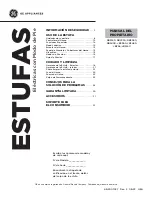
20
49-2001027 Rev. 3
Cleaning the Range – Exterior (Cont.)
CARE AND CLEANING:
Cleaning the Range – Exterior
Drip Pans
Remove the surface units. Then lift out the drip pans.
For best results, clean the drip pans by hand. Place
WKHPLQDFRYHUHGFRQWDLQHURUDSODVWLFEDJZLWK
1
»
4
cup
ammonia to loosen the soil. Rinse with clean water and
polish with a clean soft cloth.
The drip pans may also be cleaned in a dishwasher.
Clean the area under the drip pans often. Built-up soil,
especially grease, may catch fire.
'RQRWFRYHUWKHGULSSDQVZLWKIRLO8VLQJIRLOVRFORVH
to the receptacle could cause shock, fire or damage to
the range.
NOTE:
If your cooktop is equipped with shiny, silver-
colored drip pans, do not clean them in the self-cleaning
oven. Permanent damage to the finish can occur.
If your cooktop is equipped with black or gray porcelain-
coated drip pans, they can be cleaned in the oven during
the self-cleaning cycle. Before you begin a self-cleaning
cycle, remove any heavy soil from the drip pans and
SODFHWKHPRQWKHSRUFHODLQFRDWHGRYHQUDFNV'RQRW
place the drip pans directly on the oven bottom. After
the self-cleaning cycle is completed and the drip pans
are cool, wipe them with a damp cloth to remove any
remaining ash or residue.
Lift-Up Cooktop
The entire cooktop may be lifted up and supported in the
up position for easier cleaning.
The surface units do not need to be removed; however,
you may remove one to make raising the cooktop easier.
There are two side supports that lock into position when
the cooktop is lifted up.
After cleaning under the cooktop with hot, mild soapy
water and a clean cloth, lower
the cooktop. Be careful not to
pinch your fingers.
To lower the cooktop, push the
rods back and gently lower the
cooktop until it rests in place.
Be sure all surface units
are turned off before
raising the Cooktop.
















































